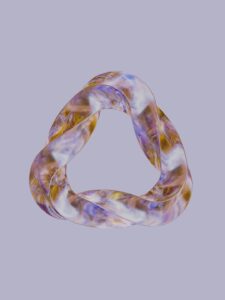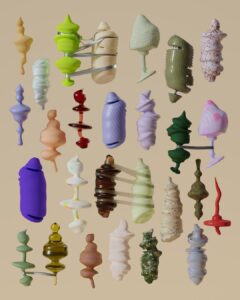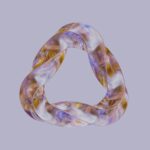Support our educational content for free when you purchase through links on our site. Learn more
What is 3D Printed? Unveiling the Magic of Additive Manufacturing [2024] 🖨️
Ever wondered what goes on inside a 3D printer? It’s not just a fancy gadget for making plastic trinkets—it’s a revolution in how we design, create, and innovate! From printing prosthetic limbs to building houses, the possibilities are truly limitless. We’re going to dive deep into the world of 3D printing, unraveling its mysteries, exploring its applications, and revealing how this technology might be changing your life as you read this!
Think you know everything about 3D printing? We’re about to blow your mind! 🤯
Quick Answer
- 3D printing (or additive manufacturing) is the process of creating three-dimensional objects layer by layer from a digital design.
- It’s like building with Legos, but with way more precision.
- The most common 3D printing technology is Fused Deposition Modeling (FDM), where a plastic filament is heated and extruded through a nozzle.
- 3D printing is transforming industries like healthcare, manufacturing, and education—and has even found its way into our homes!
- Don’t be afraid to explore the world of 3D printing! Find a printer that suits your needs, dive into the world of 3D printable objects and unleash your creativity.
Table of Contents
- Quick Tips and Facts
- The Evolution of 3D Printing: From Prototyping to Everyday Objects
- What Is 3D Printing?
- Understanding 3D Printing: A Deep Dive
- The Magic of 3D Printing: How It Works
- 3D Printing Materials: A World of Possibilities
- The Rise of 3D Printing: Applications Across Industries
- Industrial Uses of 3D Printing: Revolutionizing Manufacturing
- 3D Printing in Healthcare: A New Era of Innovation
- 3D Printing in Education: Shaping the Future of Learning
- 3D Printing at Home: Unleashing Creativity and Innovation
- The Future of 3D Printing: A World of Possibilities
- Conclusion
- Recommended Links
- FAQ
- Reference Links
Quick Tips and Facts
- Did you know that the first 3D printer was invented way back in 1983? 🤯 It wasn’t until much later that the technology really started to take off!
- Forget mass production, 3D printing is all about customization! ✨ Want a phone case with your name on it? No problem!
- From plastic to metal, 3D printers can use a surprisingly wide range of materials! We’re talking chocolate, wood filament, and even human cells!
- Think 3D printing is just for tech geeks? Think again! 🤔 Artists, educators, and even medical professionals are finding amazing uses for this technology.
Want to learn more about the incredible world of 3D printing? Read on! 👇
The Evolution of 3D Printing: From Prototyping to Everyday Objects
Remember the days when prototypes were painstakingly crafted by hand? The process was slow, expensive, and often resulted in limitations. Enter 3D printing! Suddenly, designers and engineers could bring their digital creations to life with the push of a button. But the story doesn’t end there. What started as a niche technology for prototyping has exploded into a global phenomenon, transforming industries from healthcare to fashion. We’re now seeing 3D printed houses, jewelry, prosthetics, and even food! 🤯
What Is 3D Printing?
In the simplest terms, 3D printing, also known as additive manufacturing, is like building a Lego masterpiece but with way more precision. It’s the process of creating a three-dimensional object from a digital file by laying down successive layers of material.
Think of it like this:
- You have a digital blueprint (like a blueprint for a house).
- The 3D printer reads this blueprint and “prints” it layer by layer.
- Each layer is fused together, slowly building up the final object.
It’s like magic, but with more plastic (or metal, or ceramic… the possibilities are endless!) ✨
Understanding 3D Printing: A Deep Dive
Okay, so you get the basic idea. But what’s really happening inside that mysterious 3D printer box? 🤔 Let’s break it down:
1. Design: It all starts with a digital 3D model, created using 3D design software.
2. Slicing: Next, the software slices this model into hundreds (or even thousands) of thin layers.
3. Printing: The 3D printer gets to work, depositing material layer by layer according to the sliced design. This could involve:
- Melting plastic filament and extruding it through a nozzle (Fused Deposition Modeling or FDM).
- Curing liquid resin with UV light (Stereolithography or SLA).
- Fusing powdered materials together with a laser (Selective Laser Sintering or SLS).
4. Post-Processing: Once the printing is complete, there might be some finishing touches, like removing support structures or sanding down rough edges.
The Magic of 3D Printing: How It Works
We already know it involves lasers, melted plastic, and a touch of digital wizardry. But isn’t there something inherently magical about watching a physical object materialize before your eyes? ✨ Let’s dive deeper into the different types of 3D printing technologies:
1. Fused Deposition Modeling (FDM):
- The OG: This is the most common and affordable type of 3D printing, perfect for beginners.
- How it Works: A plastic filament is heated and extruded through a nozzle onto a build platform, layer by layer.
- Pros: Affordable, wide range of materials, easy to use.
- Cons: Can have visible layer lines, limited detail on complex geometries.
Check out FDM printers from brands like:
- Creality Ender 3: Thingiverse | Amazon | Creality Official
- Prusa i3 MK3S+: Thingiverse | Amazon | Prusa Official
2. Stereolithography (SLA):
- The Detail Master: Known for its high resolution and smooth surface finish.
- How it Works: A UV laser selectively cures liquid resin in a vat, building the object layer by layer.
- Pros: Exceptional detail, smooth surface finish.
- Cons: More expensive, limited material options, requires post-processing.
Explore SLA printers like:
- Anycubic Photon Mono: Thingiverse | Amazon | Anycubic Official
- Elegoo Mars 2: Thingiverse | Amazon | Elegoo Official
And the list goes on! There’s Selective Laser Sintering (SLS), Digital Light Processing (DLP), and a whole bunch of other acronyms we won’t bore you with (for now 😉). Each technology has its own strengths and weaknesses, just like choosing the right tool for the job.
3D Printing Materials: A World of Possibilities
Remember when we said 3D printing wasn’t just about plastic? We weren’t kidding! From flexible filaments to durable metals, the world of 3D printing materials is vast and constantly evolving. Here’s a glimpse into what’s possible:
1. Plastics:
- PLA (Polylactic Acid): A biodegradable and easy-to-print plastic, perfect for beginners.
- ABS (Acrylonitrile Butadiene Styrene): A strong and impact-resistant plastic, ideal for functional prototypes.
- PETG (Polyethylene Terephthalate Glycol): A food-safe and durable plastic, often used for bottles and containers.
- TPU (Thermoplastic Polyurethane): A flexible and elastic plastic, great for phone cases and other bendable objects.
2. Metals:
- Titanium: Strong, lightweight, and biocompatible, used in aerospace and medical implants.
- Aluminum: A versatile and affordable metal, commonly used in prototyping and manufacturing.
- Stainless Steel: Durable and corrosion-resistant, ideal for demanding applications.
3. Other Exciting Materials:
- Ceramics: For creating intricate and heat-resistant objects.
- Wood Filaments: Composites that mimic the look and feel of wood.
- Carbon Fiber: Strong and lightweight, often used in aerospace and automotive applications.
And yes, even chocolate! 🍫 Imagine printing custom-designed chocolates for special occasions. The future is delicious! 🤤
The Rise of 3D Printing: Applications Across Industries
3D printing is no longer a futuristic fantasy. It’s here, it’s real, and it’s changing the world as we know it. From revolutionizing manufacturing processes to pushing the boundaries of medical innovation, here are just a few ways 3D printing is shaking things up:
1. Manufacturing:
- Rapid Prototyping: Designers and engineers can create prototypes quickly and efficiently, testing different iterations and reducing lead times.
- On-Demand Manufacturing: Products can be printed on demand, reducing waste and inventory costs.
- Mass Customization: Consumers can personalize products with unique designs, colors, and features.
Think custom phone cases, personalized jewelry, or even shoes that fit your feet perfectly. What Products Can Be Made by 3D Printing? 2024 ✨
2. Healthcare:
- Prosthetics and Orthotics: Custom-fit prosthetics and orthotics can be created at a fraction of the cost of traditional methods.
- Medical Models: Surgeons can practice complex procedures on 3D printed models of patients’ organs.
- Bioprinting: Researchers are exploring the possibility of printing human tissues and organs for transplantation.
3D printing is literally giving people a second chance at life! ❤️
3. Education:
- Hands-On Learning: Students can design and print their own creations, fostering creativity and problem-solving skills.
- Visual Aids: Complex concepts can be visualized and explored in 3D, making learning more engaging.
- Affordable Tools & Equipment: Schools and universities can use 3D printers to create their own lab equipment at a fraction of the cost.
4. Other Industries Embracing the 3D Printing Revolution:
- Aerospace: Lighter and stronger components for aircraft.
- Automotive: Customized car parts and prototypes
- Architecture: 3D printed models and even entire buildings
- Fashion: Intricate jewelry, custom footwear, and avant-garde designs.
The possibilities are truly limitless! 🚀
Industrial Uses of 3D Printing: Revolutionizing Manufacturing
Remember that quote about General Electric creating a helicopter engine with just 16 parts instead of 900 thanks to 3D printing?🤯 That’s the power of this technology in action. Industries are using 3D printing to:
- Streamline Supply Chains: Print parts on demand, reducing reliance on traditional manufacturing and shipping.
- Create Lighter and Stronger Parts: Optimize designs for weight and strength using materials like titanium and carbon fiber.
- Enable Mass Customization: Offer personalized products without sacrificing efficiency.
It’s not just about doing things faster and cheaper—it’s about doing things better. 💪
3D Printing in Healthcare: A New Era of Innovation
3D printing isn’t just changing how we manufacture products—it’s revolutionizing how we approach healthcare. Imagine a world where:
- Prosthetics are Highly Personalized: 3D-printed prosthetics perfectly match a patient’s anatomy and needs, providing greater comfort and mobility.
- Surgeons Can “Practice” Before Surgery: 3D printed models of a patient’s organs allow surgeons to plan and rehearse complex procedures, reducing risks during surgery.
- Bioprinting Could Solve Organ Shortages: Researchers are working on printing functional organs using human cells, a potential solution to the organ transplant crisis.
We’re talking about life-changing, and even life-saving, applications! 🏥
3D Printing in Education: Shaping the Future of Learning
Remember those plastic anatomical models in your high school biology class? 🤢 3D printing is bringing a much-needed upgrade to education, making learning more engaging and hands-on. Here’s how:
- Turning Abstract Concepts into Tangible Objects: Students can design and print 3D models of molecules, historical artifacts, or even mathematical concepts.
- Fostering 21st-Century Skills: 3D printing encourages creativity, problem-solving, and collaboration—skills that are essential for success in the modern workforce.
3D printing is empowering the next generation of innovators and problem-solvers! 💡
3D Printing at Home: Unleashing Creativity and Innovation
Think 3D printing is just for big companies and research labs? Think again! Affordable desktop 3D printers have made this technology accessible to hobbyists, makers, and anyone with a passion for creating.
Here are a few ways people are using 3D printing at home:
- Bringing Imaginations to Life: Print custom toys, game pieces, jewelry, home decor—the possibilities are endless.
- Fixing and Improving Everyday Objects: Need a replacement part for a broken appliance? Print one!
- Joining the Maker Movement: Connect with a community of makers and share designs, tips, and inspiration.
Ready to start your own 3D printing adventure? Check out our guides to 3D printable objects, 3D printing techniques, and 3d printing innovations.
The Future of 3D Printing: A World of Possibilities
So, what’s next for the world of 3D printing? As materials become more advanced and printing speeds increase, we can only imagine the possibilities. Here are a few exciting developments on the horizon:
- 4D Printing: Imagine objects that can change shape and function over time in response to external stimuli. That’s 4D printing!
- Sustainable 3D Printing: Researchers are exploring eco-friendly materials and processes to minimize the environmental impact of 3D printing.
- 3D Printing in Space: From building structures on the moon to manufacturing tools on demand, 3D printing is poised to play a crucial role in space exploration.
As 3D printing technology continues to evolve, one thing is certain: the future is full of exciting possibilities! 🚀
Conclusion

3D printing has come a long way from its humble beginnings as a prototyping tool. It’s now a transformative technology that is reshaping industries, pushing the boundaries of innovation, and literally changing lives. We’ve seen how it’s impacting everything from manufacturing and healthcare to education and even our own creativity at home.
While challenges remain—like the speed of production and the availability of certain materials—the future of 3D printing is undeniably bright. We’re excited to see how this technology continues to evolve and impact our world in ways we can only begin to imagine.
Do you have any exciting ideas for 3D printing projects? Share them with us in the comments! 🤩
Recommended Links
👉 Shop 3D Printers:
- Creality Ender 3: Thingiverse | Amazon | Creality Official
- Prusa i3 MK3S+: Thingiverse | Amazon | Prusa Official
- Anycubic Photon Mono: Thingiverse | Amazon | Anycubic Official
- Elegoo Mars 2: Thingiverse | Amazon | Elegoo Official
Explore 3D Printing Books:
- “3D Printing for Beginners: A Step-by-Step Guide” by J.D. Hill
- “3D Printing: The Ultimate Beginner’s Guide to 3D Printing” by Christopher Paolini
Start your 3D printing journey today! 🖨️
FAQ

What does it mean when something is 3D printed?
It means that the object was created using a 3D printer, which builds a physical object layer by layer from a digital design. Think of it like a high-tech version of baking a cake: you start with a recipe (the digital model), then add layers of batter (the printing material) until you have a finished product (the 3D printed object).
Why is it called “3D Printing”?
The term “3D printing” comes from the fact that the process creates objects with three dimensions – length, width, and height. In contrast to traditional printing, which creates two-dimensional images on a flat surface, 3D printing brings to life objects that have depth and volume.
Read more about “Where Can I 3D Print for Free? … 🖨️”
Is 3D printing good or bad?
Like any technology, 3D printing has both benefits and drawbacks.
Pros of 3D Printing:
- Customization: You can personalize objects to meet your specific needs (think custom phone cases, tailored prosthetics, even edible creations!).
- Efficiency: 3D printing can often reduce the time and costs associated with traditional manufacturing processes.
- Innovation: Enables the creation of complex designs that could not be produced using traditional methods.
- Sustainability: Reduces waste and material usage, particularly when using recycled or biodegradable materials.
Cons of 3D Printing:
- Speed: 3D printing can be slow for creating large-scale objects.
- Limited Materials: Not all materials are readily available for 3D printing.
- Cost: Some 3D printers and materials can be expensive.
- Ethics: 3D printing raises ethical questions about counterfeiting, intellectual property, and the potential for misuse.
Read more about “21 Mind-Blowing 3D Printing Statistics of 2020 … 📊”
What is the main idea of 3D printing?
The main idea behind 3D printing is to take a digital design and transform it into a tangible, physical object. It’s like bringing your ideas to life in a completely new and exciting way.
Read more about “10 Free 3D Printing Software Powerhouses for Your Ender 3 … 💥”
How does 3D printing work exactly?
Here’s a simplified breakdown of the process:
- Digital Design: You create a digital 3D model of the object you want to print using design software.
- Slicing: The software slices your 3D model into hundreds (or even thousands) of thin, horizontal layers.
- Printing: The 3D printer reads the sliced layers and deposits material, layer by layer, according to the instructions.
- Materials: Different 3D printing technologies use various materials, like plastic filaments, liquid resins, or powdered materials.
- Fusion: Each layer is meticulously fused together, solidifying the object as it takes form.
- Support Structures: Some 3D printing technologies require “support structures” to prevent parts from sagging during the printing process. These structures are typically removed after printing.
- Post-Processing: Depending on the 3D printing technology and material used, there might be additional steps involved, such as sanding, cleaning, painting, or finishing.
Read more about “How does 3D printing work exactly? “
Reference Links
- Creality Ender 3
- Prusa i3 MK3S+
- Anycubic Photon Mono
- Elegoo Mars 2
- Pros and Cons of 3D Printing | Built In
- Thingiverse
Stay tuned for more exciting insights from the 3D Printed™ team! 💡





